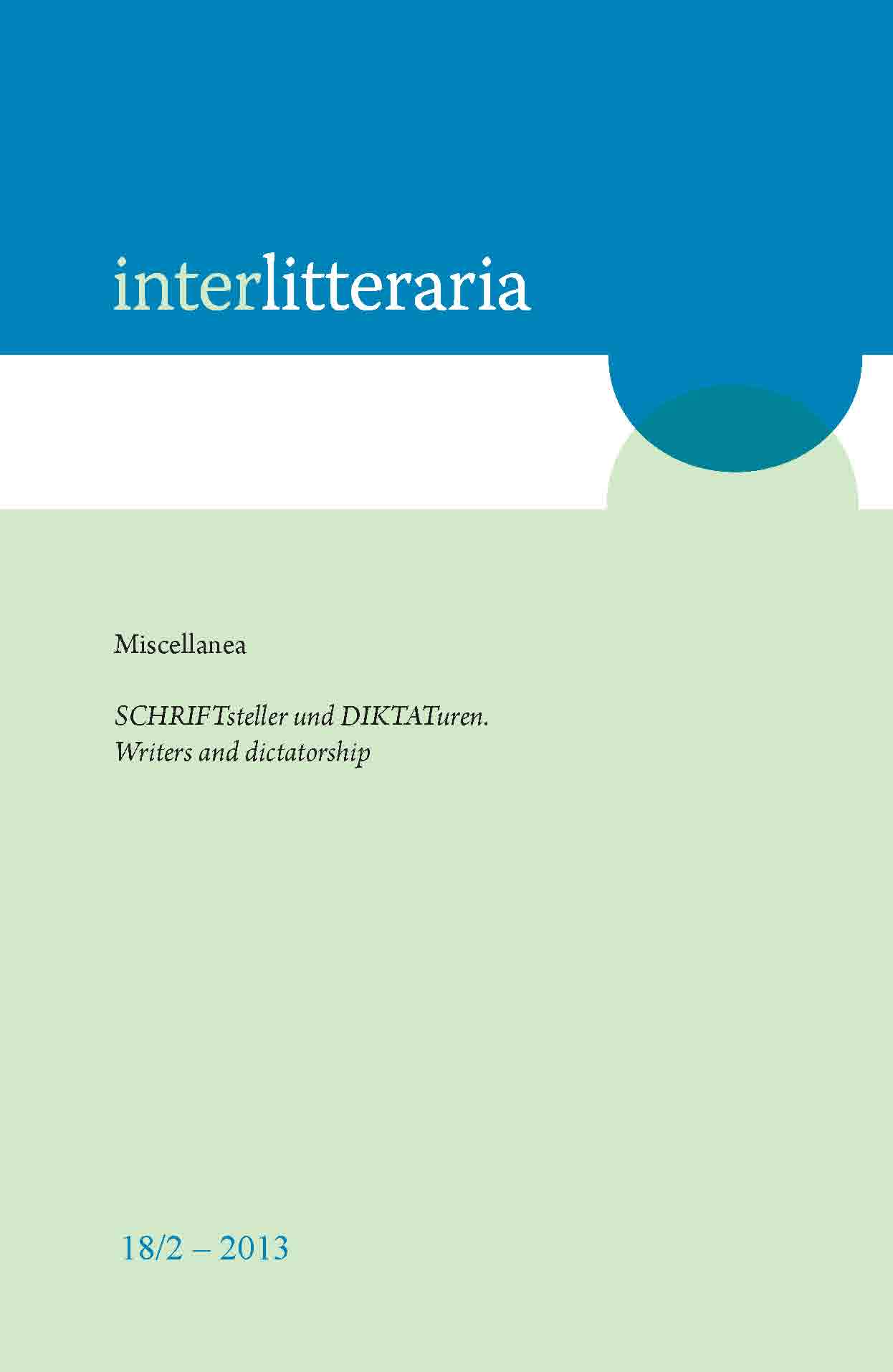On some Aspects of Life Writing in Bernard Kangro’s Kuus päeva and Seitsmes päev
DOI:
https://doi.org/10.12697/IL.2013.18.2.09Keywords:
Bernard Kangro, Estonian literature in exile, philosophical aspects of life writingAbstract
The Second World War cleft Estonian literature into two halves for half a century: the literature of the homeland and the literature of the diaspora. Bernard Kangro (1910–1994), who fled Estonia in 1944, was a prolific writer, the editor of the magazine Tulimuld and the head of the main diaspora publishing house Eesti Kirjanike Kooperatiiv. Kuus päeva (Six Days, 1980) and Seitsmes päev (The Seventh Day, 1984) are Kangro’s last novels. Kangro began drawing up plans for these two novels at the beginning of the 1970s, when western scholars were taking a deeper interest in life writing. From the perspective of form, Kangro’s novels have a special status in Estonian literature; in Kuus päeva, Kangro uses the diary form to create a meta-level in the novel with the goal of analyzing the specificity of autobiographical writing; in Seitsmes päev this meta-level is achieved through the imaginary diary of the biographer-protagonist, which consists of his reflections and experiences while writing a biography. These reflections and experiences derive from Kangro’s own preliminary research for the historical novel Kuus päeva. Seitsmes päev thus becomes the metatext for Kuus päeva. The main theme of the first novel of the dilogy is the writing of autobiography as such. Through the protagonist Andreas Sunesen, a historical figure, questions are raised concerning the concept of truth in autobiographical writing, the relations between autobiographical writing and historical writing and the function of confessionality in autobiographical narrative. The second focus of this article is on the issues connected to the writing of biography, as thematized in Seitsmes päev. In Kuus päeva, three meanings of the concept of truth can be differentiated: the truth expressed by the autobiographer (which the protagonist also refers to as “eternal truth“); the truth of historical events, which is expressed in their claim to authenticity, their correspondence or harmony with reality; and the truth about the existence of the autobiographer, which should appear as a result of the verbalization of his self-examination and memory work. The story of the mission to the eastern Baltic Sea region contained in Andreas’ autobiographical narrative points rather to the inseparability of the first two dimensions of truth, at least to the extent that the narrator of these historical events is also their witness and participant. Thus, it is unavoidable that he would relay what has happened from the vantage point of his present needs and purposes. Kangro’s novel seems to support the Italian philosopher Adriana Cavarero’s claim about self-narration: the autobiographical narrative can only answer the question of what a person was, not the question of his or her existence. In Seitsmes päev, the second novel of the dilogy, a philosophical question is foregrounded – the question of the task of the biographer. As far as the poetics of this novel is concerned, the answer to this question remains ambivalent.Downloads
Download data is not yet available.
References
<p>Annus, E. 1997. Eesti romaani narratiivseid mudeleid. A. H. Tammsaare “Tõe ja õiguse” ning B. Kangro Tartu-romaanide näitel. – J. Undusk, ed., <em>Klassika ja narratiivsus. Tammsaarest Kangroni</em>. Tallinn: Underi ja Tuglase Kirjanduskeskus, 11–58.</p><p>Augustine 1997. <em>The Confessions</em>. New York: New City Press.</p><p>Backscheider, P. R. 2004. <em>Reflections on Biography. </em>Oxford: Oxford University Press.</p><p>Bourdieu, P. 2003. <em>Praktilised põhjused. Teoteooriast. </em>[L. Tomasberg, transl.] Tallinn: Tänapäev.</p><p>Bruner, J. 1993. The Autobiographical Process. – R. Folkenflik, ed., <em>The Culture of Autobiography. Constructions of Self-Representation</em>. Stanford: Stanford University Press, 38–56.</p><p>Cavarero, A. 2000. <em>Relating</em><em> </em><em>Narratives.</em><em> </em><em>Storytelling</em><em> </em><em>and</em><em> </em><em>Selfhood</em>. London and New York: Routledge.</p><p>Eakin, P. J. 1999. <em>How Our Lives Become Stories. Making Selves</em>. Ithaka and London: Cornell University Press.</p><p>Foucault, M. 1993. About the Beginning of the Hermeneutics of the Self: Two Lectures at Dartmouth. – <em>Political Theory</em>, Vol. 21, No. 2, 198–227. <a href="http://dx.doi.org/10.1177/0090591793021002004" target="_blank">http://dx.doi.org/10.1177/0090591793021002004</a></p><p>Huizinga, J. 2007. <em>Keskaja sügis. </em>[M. Sirkel, transl.] Tallinn: Varrak.</p><p>Kaljundi, L. 2006. Hingejõu ilmed ja meelehaigus: mäss eesti ajaloomälus ja selle keskaegsetes tüvitekstides. – M. Hiiemäe, ed., <em>Paar sammukest XXII. Eesti Kirjandusmuuseumi aastaraamat 2005. </em>Tartu: Eesti Kirjandusmuuseum, 15–30.</p><p>Kalling, K. 2006. Vari minevikust. Pidalitõbi. – <em>Horisont, </em>1, 10–17.</p><p>Kangro, B. 1980. <em>Kuus päeva. Andreas Sunepoja päevaraamat ja pihtimused. </em>Lund: Eesti Kirjanike Kooperatiiv.</p><p>Kangro, B. 1984. <em>Seitsmes päev. </em>Lund: Eesti Kirjanike Kooperatiiv.</p><p>Lejeune, P. 2009. The Diary as “Antifiction”. – J. D. Popkin, J. Rak, eds., <em>On Diary</em>. Manoa: University of Hawai’i Press, 201–210.</p><p>Le Goff, J. 2000. <em>Keskaja Euroopa kultuur. </em>[M. Ott, transl.] Tallinn: Kupar.</p><p>Nielsen, T. K. 2001. The Missionary Man: Archbishop Anders Sunesen and the Baltic Crusade, 1206–21. – A. V. Murray, ed., <em>Crusade and Conversion on the Baltic Frontier 1150–1500</em>. Aldershot: Ashgate, 95–117.</p><p>Nirk, E. 1990. Bernard Kangro hilisromaanidest. – <em>Looming</em>, 5, 690–695.</p><p>Pessoa, F. 2009. <em>Tubakapood. Álvaro de Campose viimased luuletused</em>. [T. Õnnepalu, transl.] Tallinn: Pilgrim.</p><p>Smith, S., Watson, J. 2010. <em>Reading Autobiography. A Guide for Interpereting Life Narratives </em>[2. Edition]. Minneapolis, London: University of Minnesota Press.</p>
Downloads
Published
2013-12-20
Issue
Section
Articles
License
The contents of Interlitteraria are published under CC BY-NC-ND licence.


